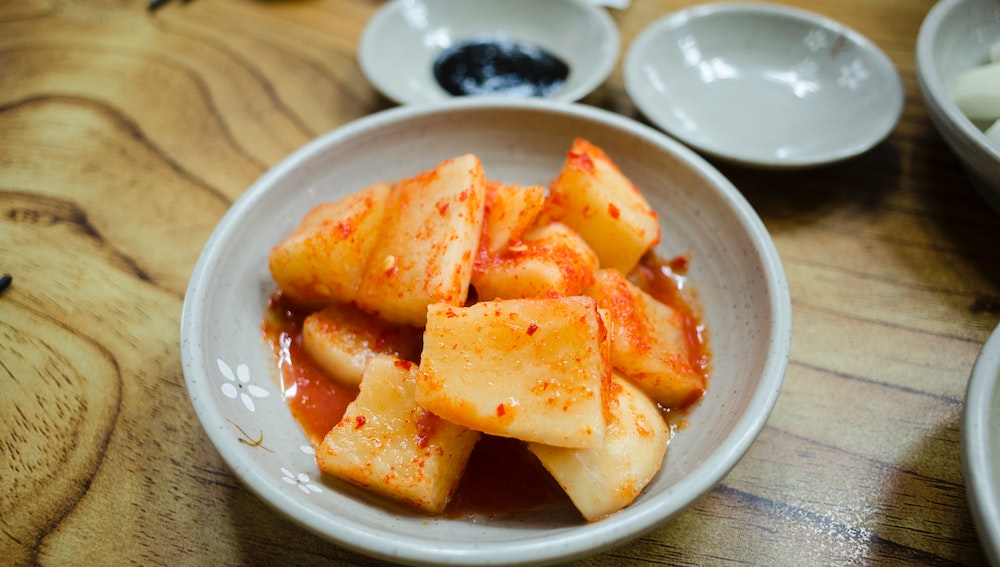As a root vegetable lover, I have always been curious about the differences between turnips and radishes.
These two vegetables may look similar at first glance, but they have distinct characteristics that set them apart.
In this article, I will explore the differences between turnips and radishes, including their physical characteristics, taste and texture, nutritional value, culinary uses, growing and storage, and health benefits.
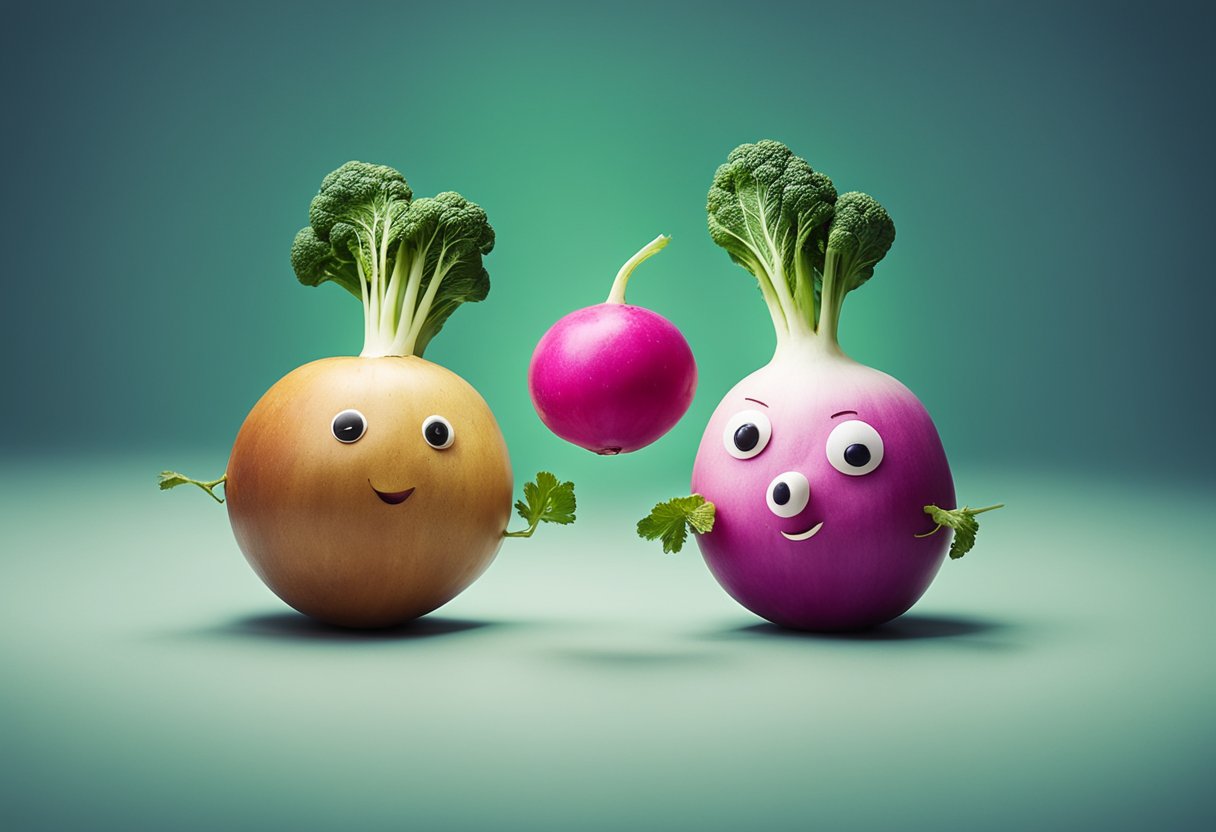
Understanding Turnips and Radishes Turnips and radishes are both root vegetables that belong to the Brassicaceae family.
Turnips have been cultivated for thousands of years and are native to Europe and Asia. They have a round shape and can be white, yellow, or purple on the outside.
The inside of a turnip is usually white and has a slightly sweet and earthy flavor. Radishes, on the other hand, are smaller and come in a variety of shapes and colors, including red, white, and black.
They have a sharp and peppery taste that can vary in intensity depending on the variety.
Physical Characteristics Turnips and radishes have different physical characteristics that make them easy to distinguish.
Turnips are larger and have a round shape, while radishes are smaller and can be round or elongated. Turnips have a smooth skin and are usually white or yellow, while radishes have a rough skin and come in a variety of colors.
Radishes can also be differentiated by their leaves, which are edible and have a distinct flavor.
Key Takeaways
- Turnips and radishes are both root vegetables that belong to the Brassicaceae family.
- Turnips are larger and have a round shape, while radishes are smaller and can be round or elongated.
- Turnips have a slightly sweet and earthy flavor, while radishes have a sharp and peppery taste.
Understanding Turnips and Radishes
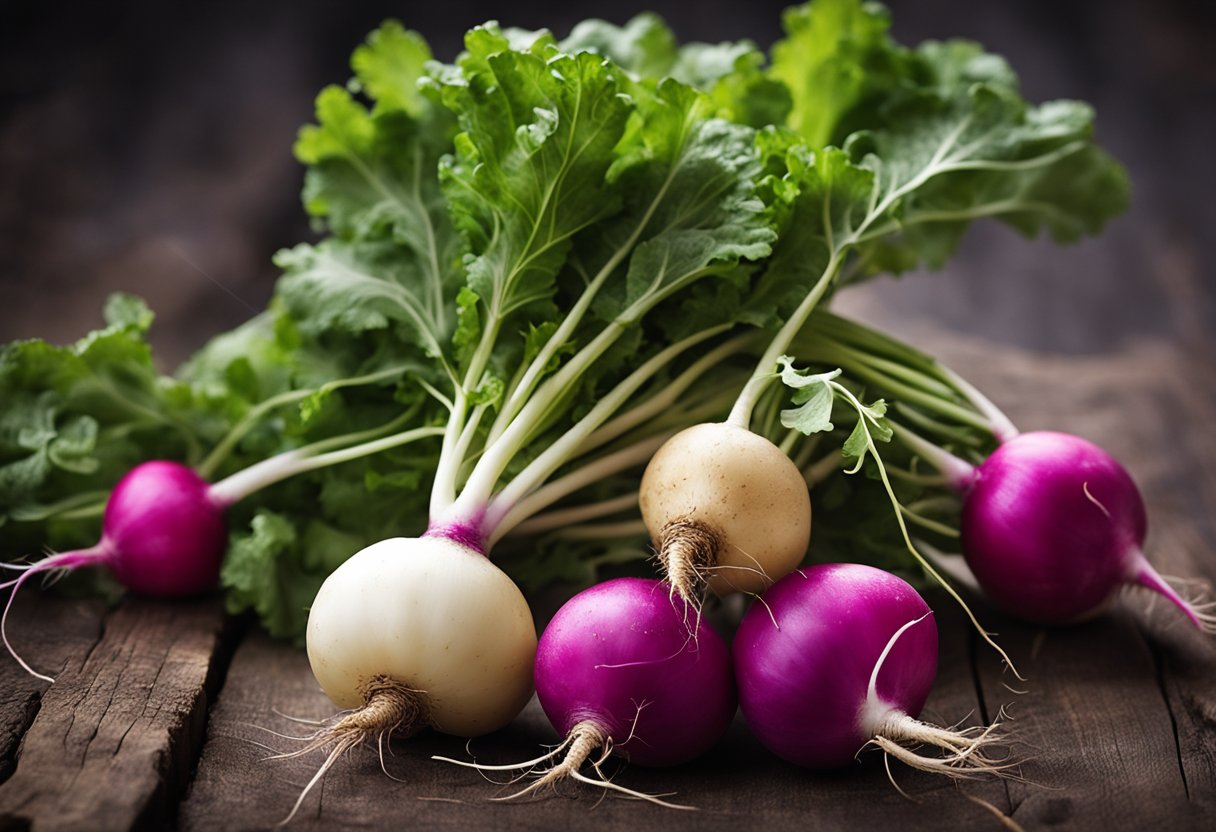
As someone who enjoys eating different types of vegetables, I find turnips and radishes to be some of the most interesting root vegetables.
Both turnips and radishes belong to the Brassicaceae family, also known as the cruciferous vegetables. These vegetables are known for their unique taste and high nutritional value.
Turnips are edible root vegetables that belong to the Brassica rapa species. They have a round shape and a white or yellowish skin.
Turnips are rich in vitamin C and fiber, making them a popular choice for people who are trying to maintain a healthy diet.
They are also low in calories, with only 28 calories per 100 grams. Turnips are often used in stews, soups, and roasted dishes.
Radishes, on the other hand, belong to the Raphanus sativus species. They have a small, round shape and come in a variety of colors, including red, white, and black.
Radishes are known for their spicy flavor and crunchy texture. They are low in calories, with only 16 calories per 100 grams. Radishes are often used in salads, sandwiches, and as a garnish.
Both turnips and radishes are root vegetables that are easy to grow and cultivate. They prefer cool weather and well-drained soil.
They are also fast-growing, with turnips taking about 30 to 60 days to mature and radishes taking about 20 to 30 days.
In summary, turnips and radishes are two popular types of root vegetables that belong to the Brassicaceae family.
They are low in calories, high in fiber, and rich in nutrients, making them a healthy addition to any diet. While turnips are often used in stews and roasted dishes, radishes are often used in salads and as a garnish.
Physical Characteristics
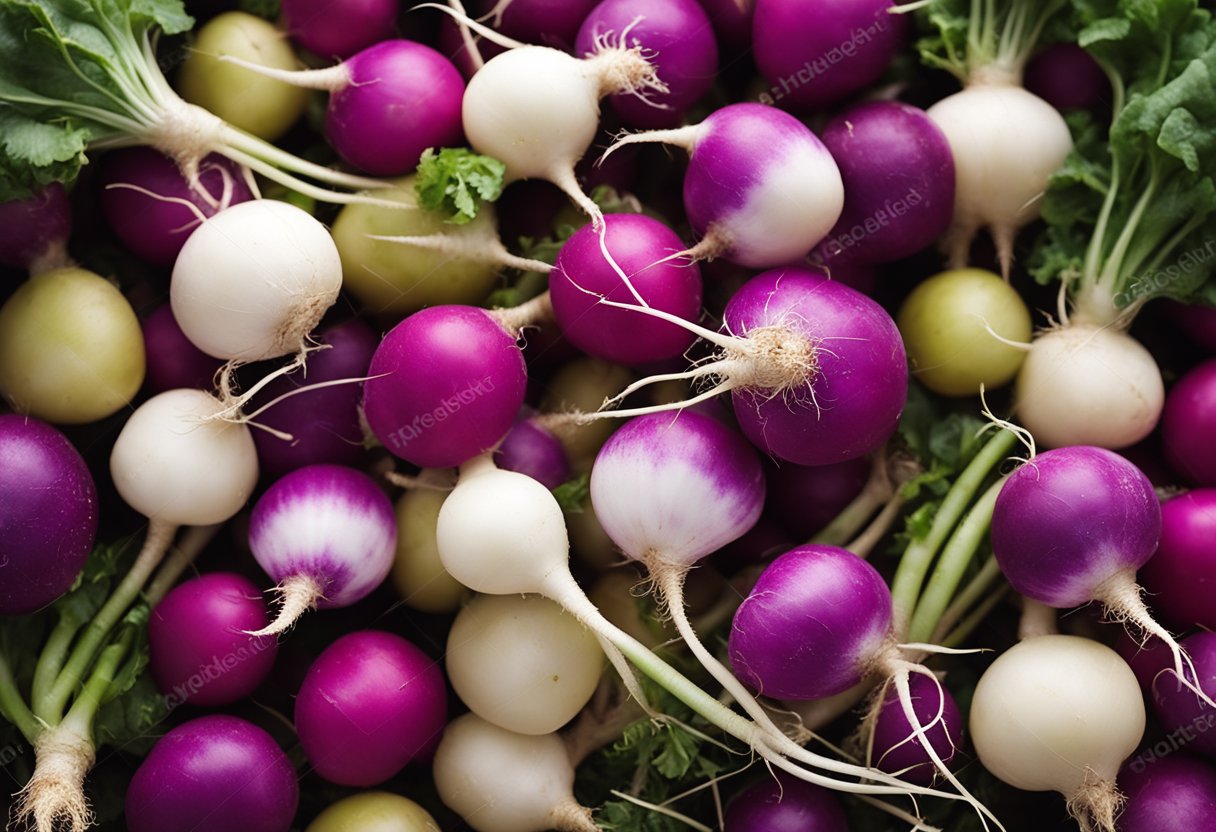
As a nutritionist, I often get asked about the differences between turnips and radishes. One of the most noticeable differences between the two vegetables is their physical characteristics.
Size and Shape
Turnips are larger than radishes and have a round or slightly flattened shape. They can grow up to 4-6 inches in diameter, while radishes usually reach a maximum diameter of 2-3 inches.
Turnips have a bulbous root that is usually white or yellow in color, while radishes have a round root that grows in bunches and can be red, white, or purple in color.
Color and Appearance
Turnips have a smooth, waxy skin that can be white, yellow, or purple. The inside of a turnip is usually white, although some varieties have a yellow or purple flesh.
On the other hand, radishes have a thin, papery skin that can be red, white, or purple in color. The inside of a radish is usually white, although some varieties have a pink or red flesh.
In terms of appearance, turnips and radishes are both round, cruciferous vegetables that belong to the Brassicaceae family.
However, they differ in size, color, and texture. While turnips have a smooth, waxy skin, radishes have a thin, papery skin.
Additionally, turnips are usually larger and have a bulbous root, while radishes are smaller and grow in bunches.
Taste and Texture

When it comes to turnips and radishes, there are some noticeable differences in taste and texture. In this section, I will discuss the various flavors and textures of these two root vegetables.
Raw Consumption
Raw turnips have a mild, earthy flavor with a slightly sweet taste. They are crisp and crunchy, similar to a raw potato or carrot.
On the other hand, raw radishes have a peppery, spicy, and zesty flavor with a crisp and crunchy texture. They are often used as a garnish or sliced thin and added to salads for texture and flavor.
Cooked Consumption
When roasted, turnips develop a milder and sweeter flavor with a slightly earthy taste. They become tender and have a creamy texture when mashed or pureed.
Roasted radishes, on the other hand, have a milder flavor and a softer texture, similar to roasted potatoes.
Overall, turnips have a milder flavor compared to radishes, and their texture is creamier when cooked. Radishes, on the other hand, have a peppery and spicy flavor with a crunchy texture when raw.
Nutritional Value
When comparing turnips and radishes, it’s important to consider their nutritional value. Both vegetables are low in calories and high in nutrients.
One of the key nutrients found in turnips is potassium. A 100-gram serving of turnips contains approximately 233 milligrams of potassium.
Potassium is important for maintaining healthy blood pressure levels and supporting proper muscle and nerve function.
Radishes, on the other hand, are a good source of vitamin C. A 100-gram serving of radishes contains approximately 14 milligrams of vitamin C.
Vitamin C is an antioxidant that can help protect cells from damage and support a healthy immune system.
Both turnips and radishes are good sources of fiber. Fiber is important for maintaining digestive health and promoting feelings of fullness.
A 100-gram serving of turnips contains approximately 1.8 grams of fiber, while a 100-gram serving of radishes contains approximately 1.6 grams of fiber.
Turnips are also a good source of antioxidants. Antioxidants are compounds that can help protect cells from damage caused by free radicals.
A 100-gram serving of turnips contains approximately 6.4 milligrams of antioxidants.
In terms of vitamins, turnips are a good source of folate and vitamin K, while radishes are a good source of most B complex vitamins.
Both vegetables contain calcium, which is important for maintaining strong bones and teeth.
Overall, both turnips and radishes are nutritious vegetables that can be a healthy addition to any diet.
Culinary Uses
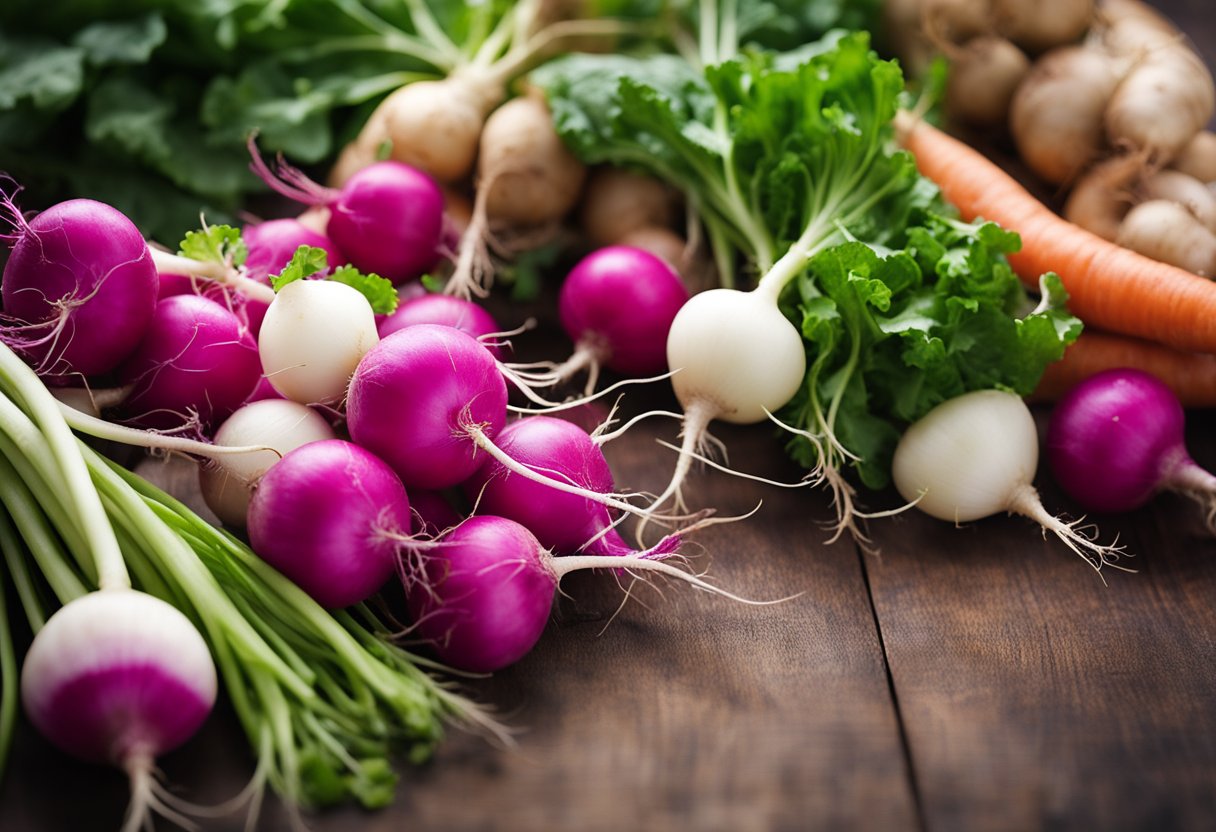
When it comes to culinary uses, both turnips and radishes are versatile vegetables that can be used in a variety of dishes. Here are some common uses for each vegetable.
Salads and Sandwiches
Radishes are often used raw in salads and sandwiches to add a crunchy texture and a spicy kick. They pair well with other vegetables like carrots, cabbage, and turnip greens.
Turnips, on the other hand, can also be used raw in salads, but they are more commonly cooked and used in stews, soups, and as a side dish.
Cooking Methods
Turnips and radishes can both be cooked in a variety of ways. Turnips are often roasted, boiled, or mashed, while radishes are more commonly sautéed or roasted. Both vegetables can also be pickled or used as a garnish.
Recipes and Substitutes
If you’re looking for recipes that use turnips or radishes, there are plenty of options available. Turnips can be used in stews, soups, and casseroles, while radishes can be used in stir-fries, salads, and sandwiches.
If you don’t have turnips or radishes on hand, you can substitute other vegetables like potatoes, rutabaga, or carrots.
Overall, both turnips and radishes are nutritious and flavorful vegetables that can be used in a variety of dishes.
Whether you’re looking for a crunchy addition to your salad or a hearty side dish, these vegetables are a great choice.
Growing and Storage
When it comes to growing turnips and radishes, both of these root vegetables are relatively easy to grow, making them an ideal choice for beginner gardeners.
Both turnips and radishes prefer to grow in cool weather and can be planted in the early spring or fall. They also prefer well-draining soil that is rich in organic matter.
To grow turnips, plant the seeds about 1/2 inch deep and 2 inches apart in rows that are spaced about 12 inches apart.
Turnips need consistent moisture, so make sure to water them regularly. They will be ready to harvest in about 30-60 days, depending on the variety.
To grow radishes, plant the seeds about 1/4 inch deep and 1 inch apart in rows that are spaced about 6 inches apart.
Radishes also need consistent moisture, so make sure to water them regularly. They will be ready to harvest in about 20-30 days, depending on the variety.
When it comes to harvesting, both turnips and radishes can be pulled out of the ground when they are mature. Make sure to harvest them before they get too large and woody.
To store turnips and radishes, remove the greens and store them in a cool, dry place. You can also store them in the refrigerator in a plastic bag or container.
Turnips can be stored for up to two weeks, while radishes can be stored for up to one week. Just make sure to keep them moist by wrapping them in a damp paper towel or storing them in a container with a little bit of water.
Health Benefits
As a nutritionist, I am often asked about the health benefits of turnips and radishes. Both of these cruciferous vegetables are packed with nutrients and can be a great addition to a healthy diet.
One of the key health benefits of turnips is their ability to lower blood pressure. Turnips are rich in potassium, a mineral that helps to relax blood vessels and reduce the strain on the heart.
This makes turnips an excellent choice for people who are looking to manage their blood pressure levels.
Radishes, on the other hand, are known for their ability to improve digestion. They are high in fiber, which helps to keep the digestive system running smoothly.
Additionally, radishes contain compounds that can help to stimulate the production of digestive enzymes, further aiding in the digestion process.
Both turnips and radishes are also low in calories, making them a great choice for people who are looking to manage their weight.
Turnips are particularly rich in vitamin C, which is important for immune function and skin health.
Radishes, on the other hand, are a good source of vitamin B6, which is important for brain function and the production of neurotransmitters.
Overall, both turnips and radishes offer a range of health benefits and can be a great addition to a healthy diet.
Whether you are looking to manage your blood pressure, improve your digestion, or simply add more nutrients to your diet, these cruciferous vegetables are definitely worth considering.
Frequently Asked Questions
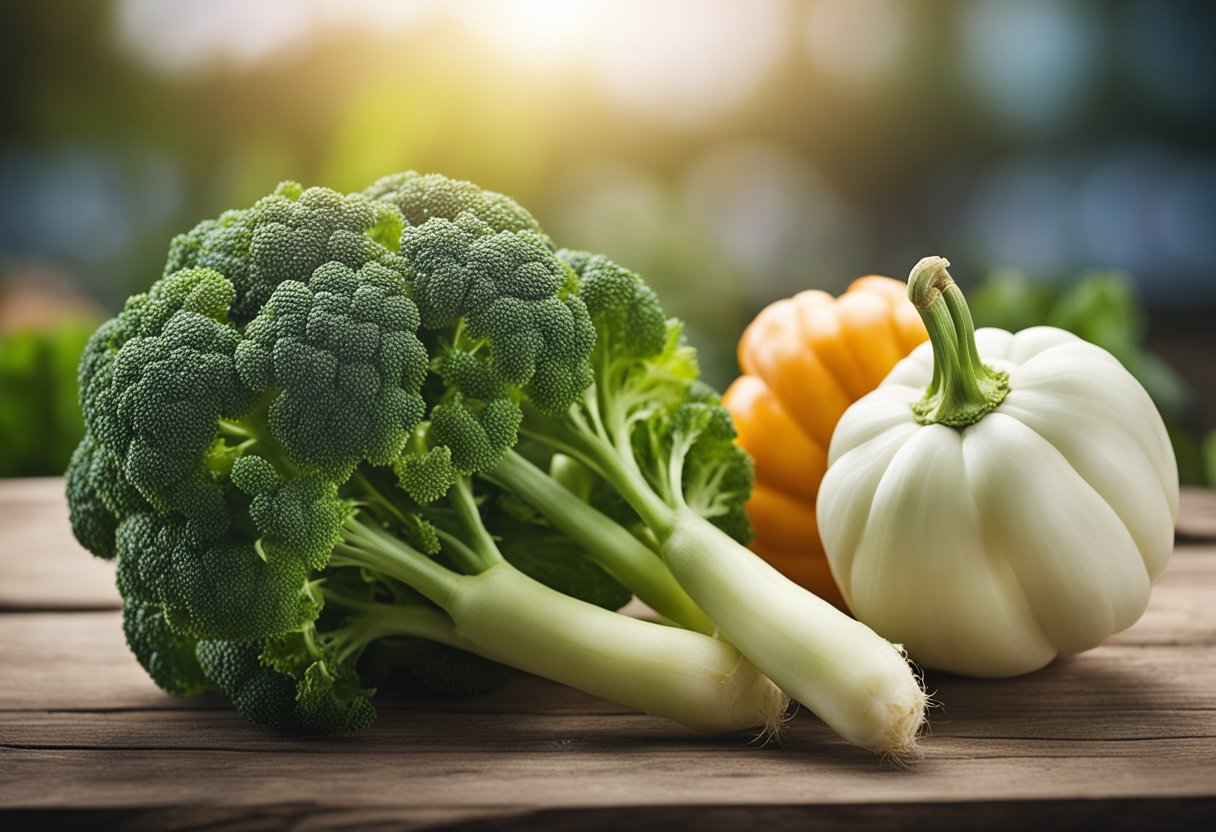
What is the difference between a turnip and a daikon?
Turnips and daikons are both root vegetables, but they differ in appearance, taste, and texture. Turnips are round and have a purple or white skin with a white flesh.
They have a slightly sweet and earthy taste and a firm texture. On the other hand, daikons are long and cylindrical with a white skin and a white flesh.
They have a milder taste and a crunchy texture. Daikons are commonly used in Asian cuisine, while turnips are more commonly used in Western cuisine.
Can you eat raw turnip?
Yes, you can eat raw turnip. Raw turnips have a mildly spicy flavor and a crispy, starchy flesh. They can be sliced thinly and added to salads or served with a dip.
Turnip vs parsnip: Which is better?
Turnips and parsnips are both root vegetables, but they have different flavors and textures. Turnips have a slightly sweet and earthy taste and a firm texture, while parsnips have a sweet and nutty flavor and a tender texture.
Both are nutritious and can be used in a variety of dishes, so the choice between the two comes down to personal preference.
Radish vs turnip vs daikon: Which one is the healthiest?
Radishes, turnips, and daikons are all healthy vegetables that are low in calories and high in nutrients. Radishes are a good source of vitamin C and fiber, while turnips are a good source of vitamin C, fiber, and potassium.
Daikons are a good source of vitamin C, fiber, and antioxidants. The healthiest one depends on your nutritional needs and preferences.
Turnip vs swede: Which one is better for roasting?
Turnips and swedes are both root vegetables that can be roasted, but they have different flavors and textures.
Turnips have a slightly sweet and earthy taste and a firm texture, while swedes have a sweet and nutty flavor and a softer texture.
Both are delicious when roasted, so the choice between the two comes down to personal preference.
Is Chinese turnip the same as radish?
Chinese turnip, also known as daikon radish, is a type of radish that is commonly used in Asian cuisine.
It is similar in taste and texture to other types of radishes, but it has a milder flavor and a larger size.
While they are both part of the same family of vegetables, Chinese turnip and other radishes are not the same thing.


